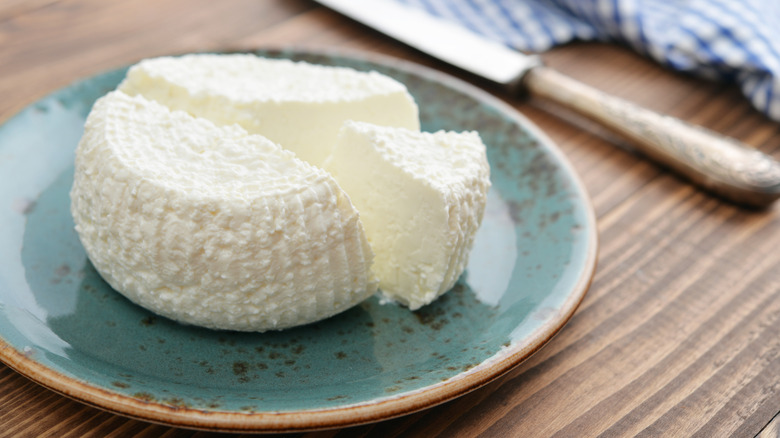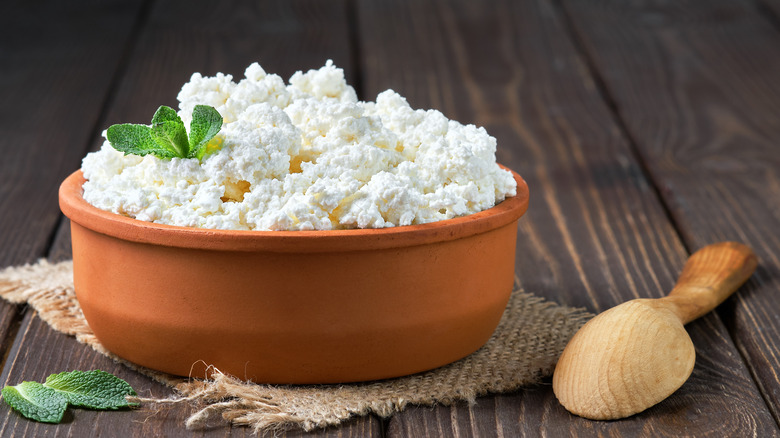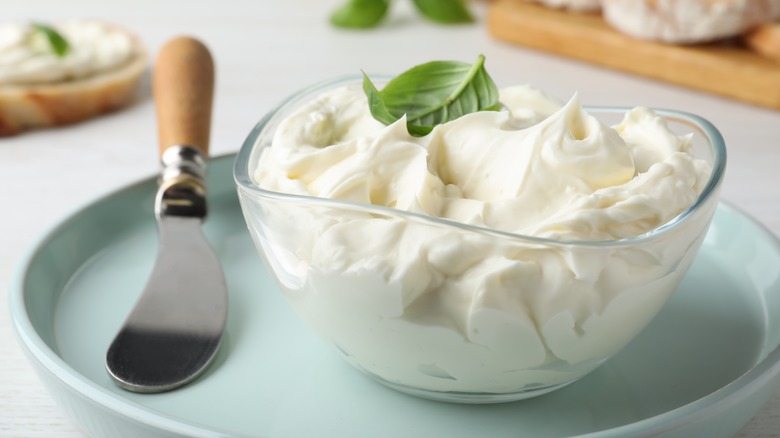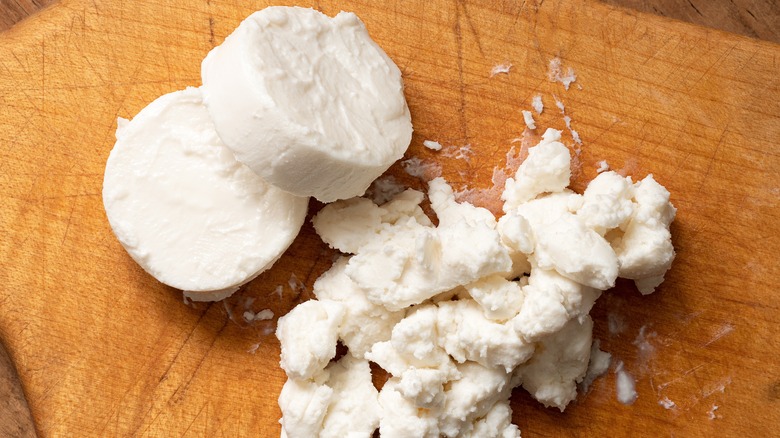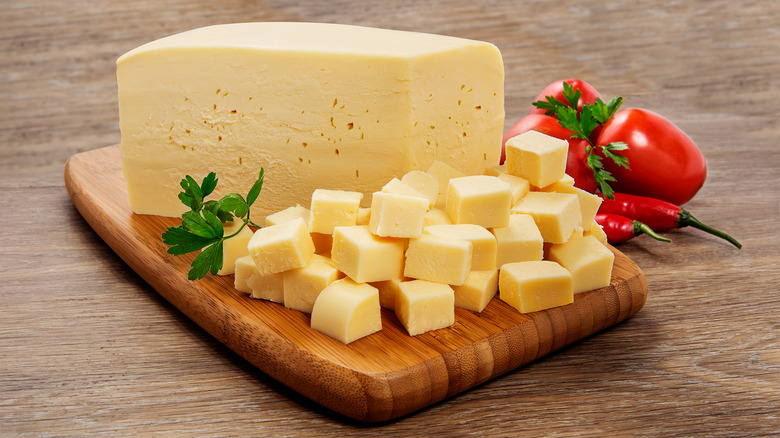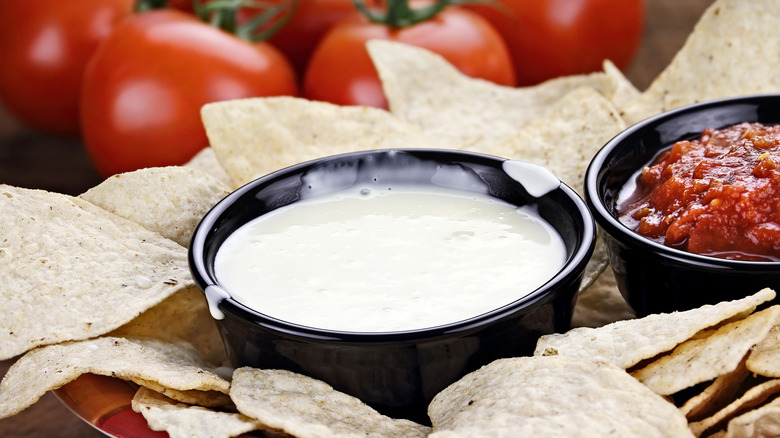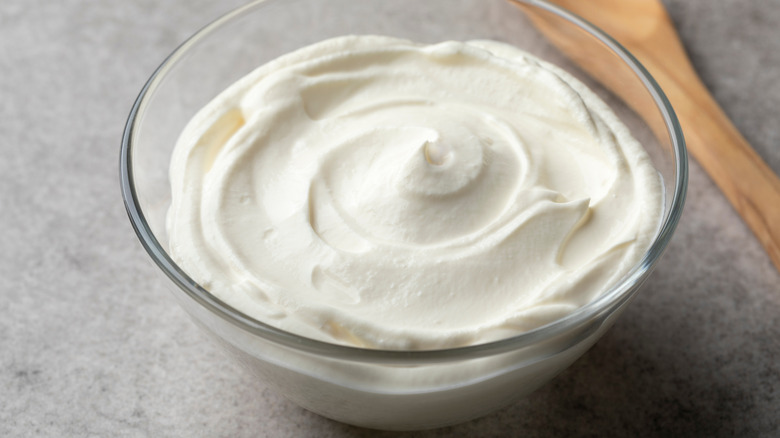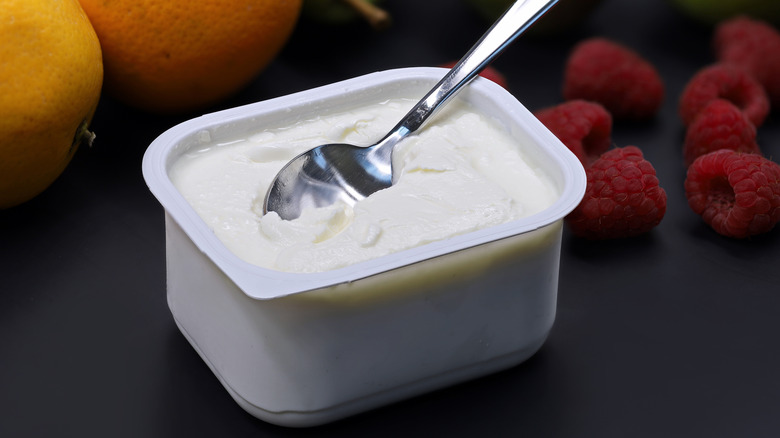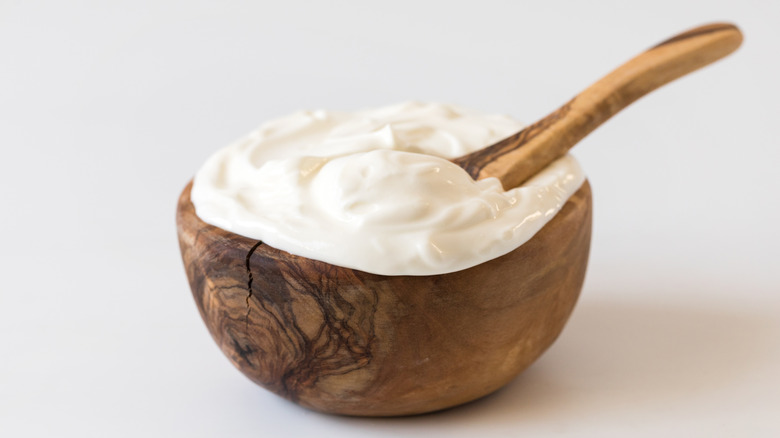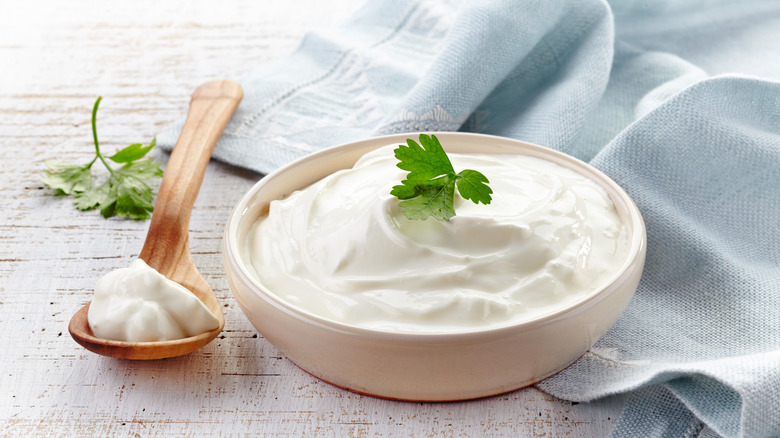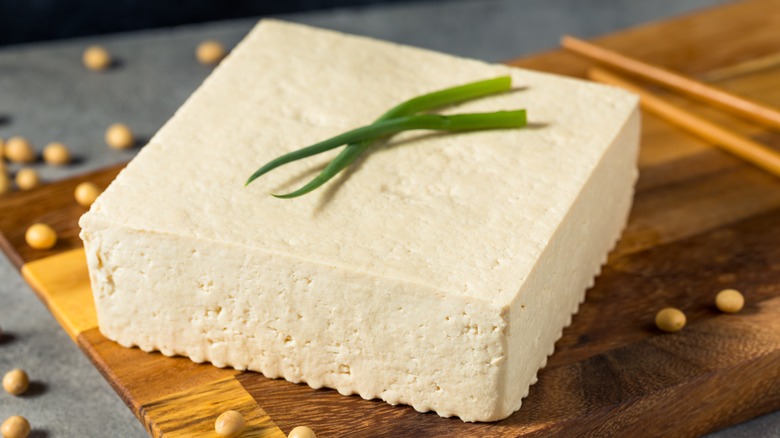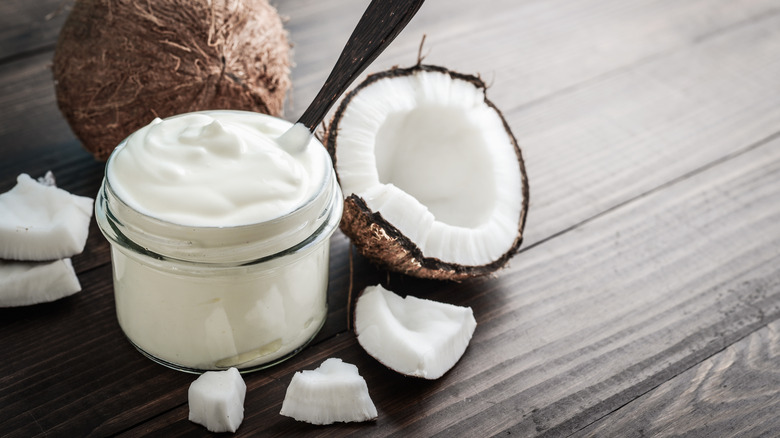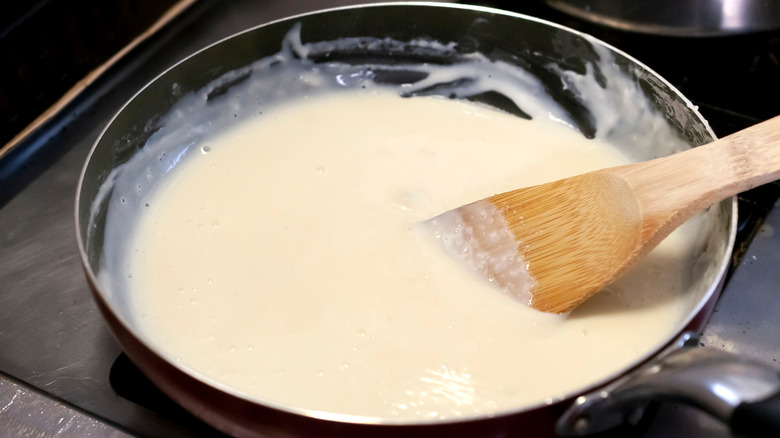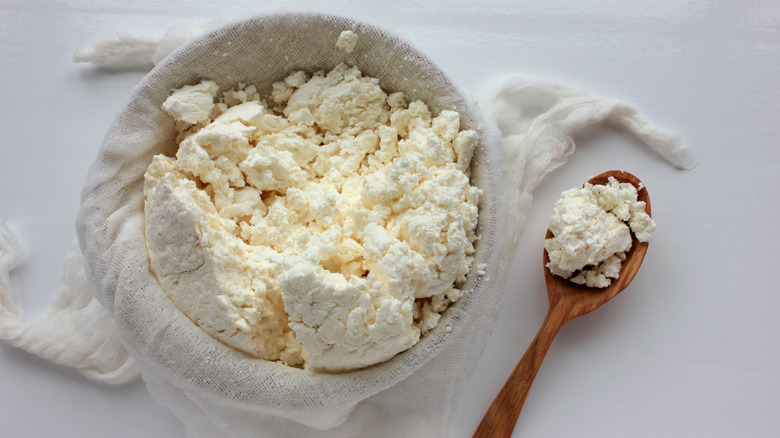13 Best Substitutes For Ricotta
We may receive a commission on purchases made from links.
Ricotta is well known for its use in Italian cuisine, particularly with pasta. However, it can be a key ingredient in several other dishes, including fritters, omelets, sandwiches, and desserts. According to DeLallo, unlike other types of cheese, ricotta is made using a cheese byproduct, or latticino, otherwise known as whey. The liquid whey is essentially "recooked" at near-boiling temperatures after it has fermented for a couple of days. The resulting curds are filtered with a cloth, and the final product is the lasagna ingredient we know and love.
Ricotta appears white and relatively firm in structure but is actually quite soft and creamy with a grainy consistency (via BBC Good Food). According to Stubborn Seed, if you purchase it fresh, it should have a rich, mild flavor with a slightly nutty taste. Because ricotta is a unique type of cheese (or, more accurately, a latticino), you may not always have it available when a recipe calls for it. But, since the ingredient often lends both its flavor and texture to a meal, you can't swap it out for just any alternative grocery item. That said, here are some of the best substitutions you can use in place of ricotta.
1. Cottage cheese
Cottage cheese is a popular substitute for ricotta for numerous reasons: According to Chatelaine, not only do the two dairy products look the same in color, but they have similar moisture levels and a mild taste. There are some key differences to keep in mind if you're considering swapping out one for the other.
Note that cottage cheese has a slightly salty taste (via Lacademie), so this substitution is recommended for more savory dishes. Cottage cheese is lower in calories and fat, making it a solid option if you want your dish to be lighter (via Livestrong). Additionally, it has a lumpier yet thinner consistency. Livestrong notes that to make it as smooth as ricotta, all you'll need to do is add it to a food processor or blender and slowly pulse or blend at a low setting. For the substitution, just use the same amount of cottage cheese as you normally would for ricotta.
2. Cream cheese
Like cottage cheese, cream cheese also has a mild flavor that makes it a good substitution for ricotta. However, unlike ricotta, it is slightly sweet and carries a little tang to it (via Cheese.com). According to Foodiosity, cream cheese is soft in texture due to being made from a blend of whole milk and heavy cream. As a result, the dairy product has a higher fat content, making it best suited for dishes that taste best with a richer flavor, says Foodiosity. This also means that cream cheese has a noticeably thicker consistency than ricotta and, as such, should be mixed fairly well before any substitution.
When replacing ricotta with cream cheese, you can use the same amounts. However, if you're making a recipe that requires a thinner consistency, consider using a small bowl to add one teaspoon of water to the cheese at a time and blending until you reach the desired consistency before adding it to your dish.
3. Goat cheese
Goat cheese (not to be confused with sheep cheese) is packed with protein and other nutrients, making it a fairly healthy substitution option. There are actually multiple kinds of this dairy product, also known as chèvre, making goat cheese pretty accessible and versatile no matter what type of dish you're trying to prepare. That said, if you want to use it as an exact replacement for ricotta, it's best to stick with a type that is closest in flavor and consistency.
Fresh chèvre is a bit more subtle in taste and easily spreadable compared to its own soft-ripened or aged variety (via The Manual). Therefore, it is the ideal alternative dairy product to use when you're in a pinch. However, according to Castello, goat cheese generally has a pronounced, bitter flavor compared to other types of cheese and is on the salty side. For this reason, it is best to use this substitution when making savory dishes. You can follow a one-to-one ratio for replacement, but make sure you cut back on the salt to compensate for the difference in sodium.
Alternatively, depending on your recipe's needs, you might consider using aged goat cheese if you prefer to have a more forward, natural, earthier taste in the completed dish.
4. Italian cheeses
Ricotta is frequently used in Italian cuisine, so it makes sense that other types of Italian cheeses, including parmesan, mascarpone, and mozzarella, can be great substitutes. Parmesan cheese (which is technically a slightly bitter copycat of Parmigiano Reggiano, according to Cheese.com) has a somewhat harder consistency and more fat. So, while it isn't best as an exact replacement, it can be with the addition of other ingredients like cottage cheese to keep its taste and texture balanced.
Mascarpone is similar to cream cheese in that it is on the thicker side with a mild, sweet, and milky flavor (via Julie's Cafe Bakery). For that reason, when used as a ricotta substitute, it is best fit for desserts such as cannolis, tiramisu, and cheesecake. To match the consistency of the latticino, simply add a bit of cream to thin it out.
When you think of "Italian" cheese, mozzarella may be another variety that comes to mind. Since mozzarella is actually made with whey, in terms of relativeness, it may seem like a fitting match for ricotta. However, it is a bit stringier in comparison, so you will need to adjust your ratios accordingly for the substitution to account for the texture.
5. Queso fresco
Queso fresco can actually make a great alternative if you happen to be out of ricotta. According to Gluten Free Club, queso fresco — not to be confused with queso blanco — is made in nearly the same way, the only difference being that it has less moisture. The benefit of using queso fresco is that it also has a mild, tangy, milky flavor, making it suitable for creamy, warm fillings and crumbled toppings (via Isabel Eats). It's an even better cheese alternative for ricotta if it's for a dish that is particularly on the spicier side.
Simply use a one-to-one ratio for this substitution, but adjust your seasoning as needed, as queso fresco tends to be a bit saltier in flavor. You can also dial back on the queso fresco and add a splash of water for moisture if you prefer to have more control over the sodium levels of the final product.
6. Crème frâiche
Crème frâiche is a smooth and creamy dairy ingredient that is often used in savory dishes. Like ricotta, it is also considered a "secondary milk product" (via Julie's Cafe Bakery). However, due to how it's processed, crème frâiche tends to be thicker and higher in fat (via Club Zest Gym), resulting in a distinct richness that's great for thickening sauces and soups.
In terms of taste, this ingredient shares a similar flavor profile with ricotta in that it is also slightly sour and salty, though it has an additional nuttiness. However, Julie's Cafe Bakery also notes that the former is generally more buttery, whereas the latter has more tang. That said, you can use crème frâiche for desserts like pies and cakes, and sides like mashed potatoes. It can also be used to complement most spices. If you don't happen to have this ingredient readily available, you can make your own crème frâiche at home by combining heavy cream and buttermilk.
7. Quark
Quark is another type of dairy product that is made from curdling a mix of pasteurized skim milk, lactic acid, and rennet. According to Kitchen Stories, it's considered a type of cottage cheese but has a taste and texture resembling that of yogurt. Quark works as an ideal substitute in dips or as a spread (via BBC Good Food). However, the ingredient is relatively versatile, so it can also be used for sweet and savory dishes, from cupcakes to salad dressing.
It does differ in consistency compared to ricotta, so depending on the dish you're trying to make, you can whip it up for a fluffier texture or chill it in the refrigerator to thicken it, says Good to Know. And according to the International Desserts Blog, you can also mix quark with heavy cream to achieve a thicker consistency.
Unlike some of the other substitutions on this list, preparing the homemade version of quark is a bit more involved, so unless you're a cheese-making aficionado, it may be best to use a store-bought variety — or, at that point, simply purchase more ricotta.
8. Greek yogurt
Greek and standard yogurt are alike in that they are both made with the same ingredients and go through the same fermentation process. However, what makes Greek yogurt unique — and, therefore, a better alternative for swapping out ricotta — is that it is strained after culturing, resulting in a thicker consistency (via Healthline). Generally, Greek yogurt is a popular substitute in recipes that require a smooth, creamy, and moist result. If you happen to be out of sour cream, heavy cream, mayo, or ricotta, but have plenty of this ingredient on hand, you're in luck. This particular substitution works best if you happen to have just a little bit of the latticino left.
According to Undeniably Dairy, for every cup of ricotta you need, replace it with ½ cup of ricotta mixed with ½ cup of Greek yogurt. However, if you're all tapped out, simply use ¾ cup of yogurt to replace 1 cup of cheese (via Miss Vickie).
9. Sour cream
Another common substitution in recipes, sour cream is the result of fermented pasteurized cream with added lactic acid. It is actually a relative of crème frâiche, though thinner in consistency and with less fat (via Nourish). If you're in a pinch and don't happen to have sour cream on hand — or any of the other swappable ingredients on this list, for that matter — making this cream at home is easy. According to Gemma's Bigger Bolder Baking, all you need is whole milk, heavy or whipping cream, and lemon juice or vinegar.
Because sour cream is distinctly more tart than ricotta, use it to replace the latticino in baked goods such as cakes or biscuits, or dips. A one-to-one ratio is standard for this substitution, but you may need to adjust the amount depending on the recipe. For example, beyond baked goods or dips, you might need additional sour cream or a mix of sour cream and butter for a thicker, creamier consistency in sauces.
10. Tofu
For the lactose intolerant or those who follow a vegan diet, tofu makes a great replacement for ricotta, especially for savory dishes. Not only is the texture of this soy product similar to the cheese, but it can easily resemble it too. It also acts as a sponge in meals, soaking up and mimicking any strong flavors present. As an added bonus, tofu is also high in protein, so as a substitution in a dish that traditionally includes meat as an ingredient, like lasagna, it easily makes up the difference nutritionally.
Use firm or extra-firm tofu if you want it to achieve the same crumbly consistency as cheese. Otherwise, silken tofu also makes a nice, creamier substitute for ricotta, if needed. Simply drain a block of tofu, add it to a food processor, and pulse (via Feasting at Home). Mix in nutritional yeast and seasonings to amplify the cheesy flavor. Once you have your ideal blend of tofu and extra seasonings, swap it out at a one-to-one ratio with the latticino.
11. Coconut cream
Another vegan-friendly and lactose-free alternative, coconut cream is derived from coconut milk and is a very versatile ingredient. Its thick texture is ideal for various soups, sauces, and dressings. Coconut cream is also rich in flavor, so it's perfect for enhancing savory meals like curry (via Healthline). Finally, coconut cream is slightly sweet in taste, similar to ricotta, so it can also be used in desserts such as pudding, cookies, and more.
You can actually use coconut cream to make vegan ricotta cheese. According to Loving It Vegan, all you need beyond this ingredient is slivered almonds, nutritional yeast, and distilled white vinegar. Once it's prepared, swap it out for ricotta at a one-to-one ratio.
If you only happen to have cans of coconut milk at your disposal, you can easily use them as a resource to make coconut cream. Chill coconut milk in the refrigerator overnight, and once you open the can, you'll find that the milk fat has separated and floated to the top (this is the coconut cream). From there, just skim it out of the can to use in your next recipe.
12. Béchamel sauce
Also known as "white sauce," béchamel sauce is a combination of flour, milk, butter, and optional seasonings (usually nutmeg, salt, and pepper) that often serves as a base for other sauces (via Recipes from Italy). Think of it as a type of roux. Béchamel has a creamy consistency resembling that of Alfredo sauce — though its actually quite different, according to The Seattle Times.
Béchamel sauce is extremely versatile and suitable for dishes like casseroles, soufflés, grilled roasted meats and vegetables, pasta, quiche, and more. Therefore, if you're looking to replace ricotta in any of these savory meals, this creamy ingredient is the way to go. Its simplified components mean that you can easily make it a home, even if you don't have a store-bought version readily available. If you happen to still have a little bit of ricotta left, try combining equal parts ricotta with béchamel sauce for a creamier result (via Foods Guy).
13. Homemade ricotta
Finally, if you're really keen on using ricotta rather than a substitute, you can make your own ricotta cheese with just a few basic ingredients: whole milk, kosher salt, and lemon juice. According to The Cheese Professor, you can also use vinegar instead of lemon, depending on the type of mild taste you want to achieve with the end product.
Those who are lactose-intolerant or vegan, fear not — you can also make vegan-friendly ricotta. All you need are cashews, lemon, and nutritional yeast. Use the end product just like you would with regular cheese in your next dish.
Made fresh, the latticino will typically last up to three days in the refrigerator, so ensure you use it in your dish within that time frame for the best results. You'll find that with homemade ricotta, it comes out to be a lot lighter than your typical store-bought variety. It's a refreshing change, so don't be surprised if you end up making your own regularly!
